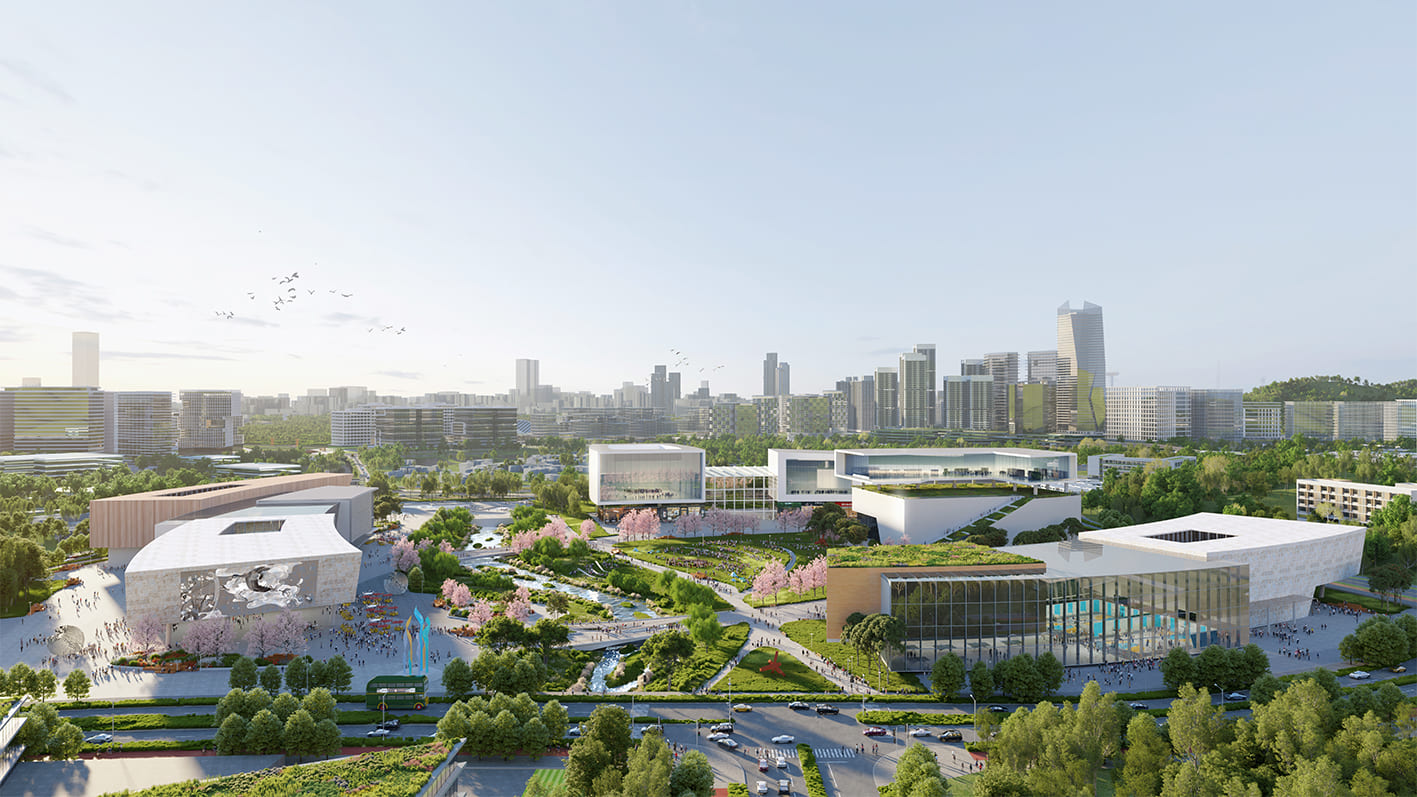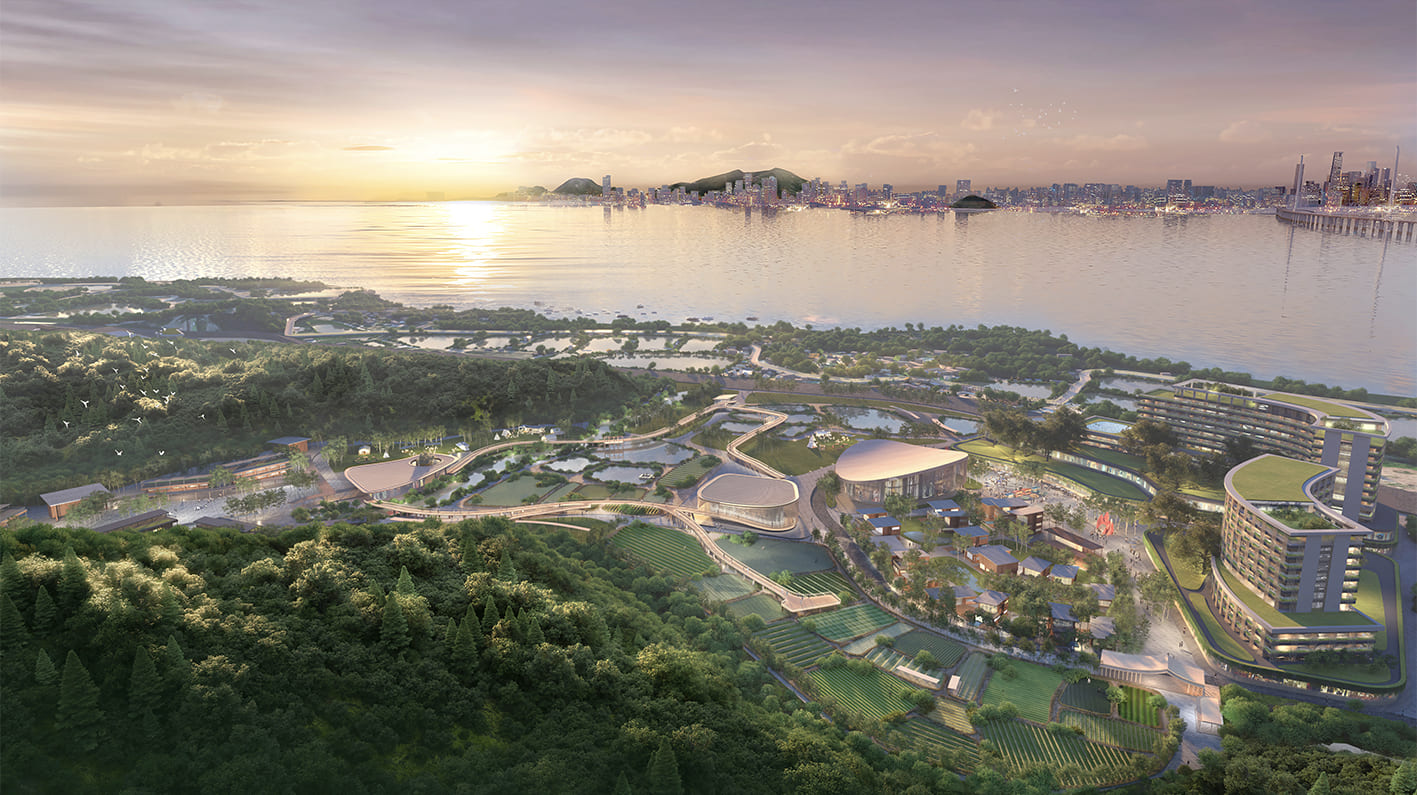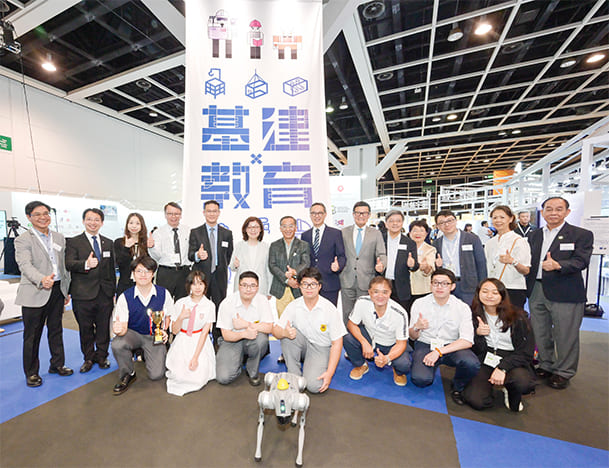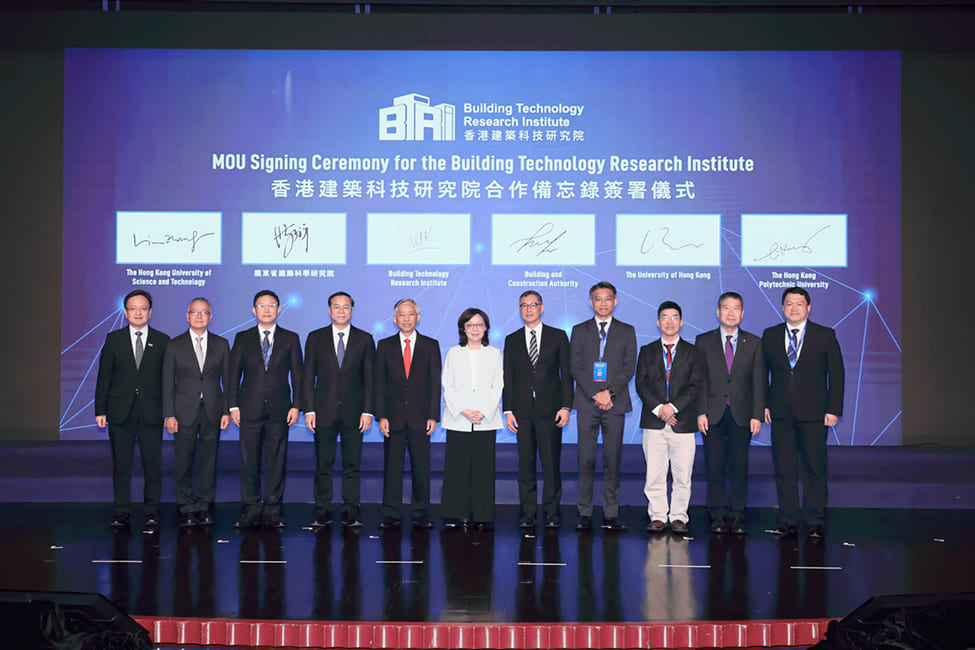


Civil Service Newsletter Editorial Board

NM is one of the key policy initiatives of the Government. NM has an area of 30,000 hectares, about one-third of Hong Kong’s total area. It covers Yuen Long and North districts, and is adjacent to Shenzhen’s boundary zone with the greatest development momentum. As a new engine for the future economic development of Hong Kong, NM is also a green and livable new community, and a new platform for co-operation in the Greater Bay Area.
Ms Linn said that with NM entering the development stages and “spade-ready sites” made available gradually, the Chief Executive has proposed in this year’s Policy Address that the level of decision-making for the NM development will be raised by establishing the Committee on Development of the Northern Metropolis under his leadership. Three working groups will be set up under the committee, focusing on attracting enterprises to engage in the building of the superstructure and industry establishment, as well as streamlining workflows and removing unnecessary barriers and restrictions. Dedicated legislation will also be introduced to accelerate the NM development. These show that the Government is striving to speed up the NM development for further developing our economy and improving people’s livelihood.
To ensure effective implementation of the NM project, Ms Linn added, “The NM project is a cross-bureau undertaking. The Northern Metropolis Co-ordination Office (NMCO) under DEVB assumes an advocacy and coordinating role, both internally and externally, to co-ordinate the hardware and software development of NM with other bureaux at the strategic level for enhancing the quality of implementation.”
Ms Linn stressed that in order to enhance the speed and efficiency in the NM development, the Government should always keep an open mind, actively listen to the voices of the industry stakeholders, and continue to remove barriers and restrictions for them. She elaborated, “For developers which own land in NM and intend to amend the land use for relevant developments, we will provide facilitation for the industry as far as possible. The in-situ land exchange arrangement has also be enhanced. On the other hand, we will conduct the expression of interest (EOI) exercise before inviting tenders for suitable projects to gauge the market demand, so as to formulate the terms of tenders that can better cater for the actual situation.”
This two-way communication mechanism has been fully implemented under the three recent pilot projects of large-scale land disposal approach in NM. DEVB received a total of 22 EOIs from the market for the projects in Hung Shui Kiu/Ha Tsuen New Development Area (NDA), Fanling North NDA and San Tin Technopole. She said, “The industry has put forward a number of constructive suggestions, including greater flexibility in the development period to enhance flexibility in the planning of the projects. There were also views that the implementation schedules of ancillary facilities surrounding the land parcels should be clearly set out in the tender documents. We are now analysing the views collected which reflect the market expectations, in order to finalise the details and terms of the future tenders.”


Speaking of the large-scale land disposal approach, Ms Linn remarked that it is one of the innovative and diversified development approaches in NM. “The Government identifies sizeable parcels of land, including those with commercial value and public facilities, for collective development by successful bidders. This approach can better leverage market forces to expedite the NM development while reducing the financial burden on the Government.” She revealed that DEVB plans to first commence the tendering work for the pilot project of land parcels in the Hung Shui Kiu/Ha Tsuen NDA in the fourth quarter of this year.
Apart from taking forward the three pilot projects under the approach of large-scale land disposal, the Government has also adjusted its development strategy by cancelling the tender for two sites in Yuen Long and Hung Shui Kiu, and has adopted a more targeted approach to utilise the land resources. “The Yuen Long site has been handed over to the Hong Kong Science and Technology Parks Corporation to establish a microelectronics ecosystem in the Yuen Long InnoPark. As for the Hung Shui Kiu site, the plan is for a company established by the Government to take up the management and operation in the form of an industry park.” She explained that the views of the innovation and technology (I&T) sector as well as the logistics sector on the industry development strategy in the area had been fully taken into account. “We hope that these two sites will be put into optimal use to allow them to exert a greater role in promoting industry development. It is encouraging that the market is in general supportive of the approach as it can better tie in with the market needs.”
All of these strategic planning approaches have formed an integral part of NM’s overall development blueprint. As the construction projects in NM are being taken forward at full steam, Ms Linn outlined the vision of developing NM into a community ideal for people to live, work and travel. “NM will not only provide a quality living environment for our people, but will also attract a variety of industries to establish presence in the area, creating industrial parks one after another. Meanwhile, with the natural ecological features, NM will become an ideal community characterised by economic vitality and sustainable development.”
The Government strives to promote island and coastal tourism. DEVB takes charge of three projects under large-scale land disposal, which include developing the ex-Lamma quarry site into an area for resort and outdoor recreational uses; developing Cheung Sha, Pui O, Shui Hau and Shek Pik into the South Lantau Eco-recreation Corridor; and developing Tsim Bei Tsui and Pak Nai into eco-tourism nodes. DEVB earlier invited the market to submit EOIs for these three projects.
Ms Linn mentioned, “This is the first time in recent years that the Government has initiated large-scale land disposal for the building of new tourism and recreation areas. Market views are particularly important to us. Take the Mainland and Singapore as examples. Both places have developed mature resort operation models. When planning for resorts with local characteristics, we need to widely gauge views from the industry to ensure that the development plan can suit the needs of the market and highlight Hong Kong’s strengths.”
Ms Linn pointed out that the three projects have their own features, among which Tsim Bei Tsui and Pak Nai encompass natural habitats that are of great ecological importance and landscape value. She stressed, “When promoting eco-tourism, ecological conservation must be given priority consideration. We propose that a coastal protection park should be established along Deep Bay coastal areas to actively conserve the ecology. As for the land of lower ecological importance in the area, including existing brownfield sites, we consider that an appropriate level of tourism development can be allowed. In addition to eco-tourism and recreation facilities, hotels and resorts that are compatible with the surrounding environment and an appropriate amount of medium- and low-density private housing can also be provided to support the relevant development.”
Under the concept of “urban-rural integration” and rural tourism development for NM, DEVB hopes to provide facilitation for suitable village houses to develop small-scale home-stay lodgings and offer food and beverages. In this respect, Ms Linn said that NMCO is liaising with relevant departments to explore appropriate measures. She explained, “Take the development projects of small-scale home-stay lodgings as an example. We should adopt relatively flexible vetting standards for these projects in respect of land planning and regulation of supporting facilities as compared to those for building 10-plus-storey guesthouses.” She added that DEVB will formulate guidelines on “urban-rural integration” for NM.

In view of the decline in construction volume in the private construction market in recent years, Ms Linn pointed out that the Government will continue to invest in the formation of land, infrastructure works and construction of facilities that are required by the community. As proposed in the Policy Address, on the basis that the original estimate for the average annual capital works expenditure was about $120 billion in the coming five years, the Government will earmark an additional $30 billion in the next two to three years to increase expenditure on works projects, thereby ensuring the construction industry’s stable development and creation of job opportunities. “Currently, public sector projects, i.e. projects undertaken by the Government and public organisations, account for about 60% of the total construction volume in Hong Kong, while private sector projects account for 40%. With the development of NM in full swing, and the successive implementation of various major projects such as hospital expansion, the construction volume in the public sector will steadily increase. Nevertheless, we will maintain strict fiscal discipline and manage public works expenditures prudently.” Meanwhile, the Government is implementing a number of measures to rationalise the project approval procedures to help developers expedite the works.
Given that the construction industry is facing a structural problem of an ageing workforce, Ms Linn emphasised that promoting technological application is a dominant trend. She said, “In the face of labour shortages, we cannot solely rely on imported labour. We need to keep pace with the times by making good use of technology to increase productivity, and identify the future development direction of the construction industry.” She opined that application of technology can effectively attract new blood into the industry. As the younger generation is particularly interested in artificial intelligence, Building Information Modelling (BIM) technology, operating robots, etc., relevant innovative elements can increase the appeal of the industry.
The Building Technology Research Institute (BTRi) established last year plays a key role in promoting innovation in the construction industry. Apart from conducting applied research and development in areas covering innovative construction materials, construction methods and technologies, BTRi also devises and enhances construction standards, conducts testing and provides accreditation. Ms Linn indicated that BTRi, as a limited company wholly owned by the Government, is more flexible in operation than government departments and can more effectively promote co-operation among the Government, industry, academia, and research sectors. In just one year, BTRi has conducted a number of applied scientific research projects through pilot projects in public works projects. Besides, it has successfully launched the Modular Integrated Construction (MiC) Manufacturer Accreditation Scheme to elevate the standards and reliability of MiC modules. At present, certificates have been presented to eight Mainland accredited manufacturers. BTRi is also preparing to implement a certification scheme for construction products and establish a central database to promote local application of high-quality and cost-effective construction products from the Mainland and overseas. “BTRi generates revenue by conducting applied research and development as well as providing accredited certification services. Such self-generated incomes enable BTRi to further expand co-operation with scientific research institutions in other regions.”
Ms Linn said that another major work is promoting professional development of the construction industry as we need talent at different levels to sustain the development of our construction industry. DEVB established the Centre of Excellence for Major Project Leaders (CoE) in 2019. As the first of its kind in Asia, CoE offers a high-level project management and leadership development programme to senior government officials and leaders of major projects. CoE has also organised various international summits and conferences from time to time to promote exchanges and collaboration with international organisations as well as overseas and Mainland professional leaders, with a view to continuously enhancing the professionalism of the construction industry, and its capabilities in innovation and cost-effectiveness management.
Last November, DEVB organised the three-day inaugural International Infrastructure and Projects Leaders Summit, bringing together more than 500 prominent infrastructure leaders and experts from over 20 countries and economies around the globe. At the Summit, these leaders and experts delved into the strategies and policies of future infrastructure delivery plans, and shared their insights on project implementation and management. Riding on the success of the inaugural summit, DEVB plans to host the second International Infrastructure and Projects Leaders Summit in 2026 in order to showcase Hong Kong’s outstanding achievements and innovative technologies in the infrastructure field, tell good stories of Hong Kong and establish the “international infrastructure centre” brand.
Moreover, the Government also attaches great importance to enhancing the “quality” and “quantity” of training for local workers. DEVB has adopted a multi-pronged strategy, and has worked closely with the Construction Industry Council (CIC) and the industry. CIC has joined hands with partner training organisations to double the number of training places for skilled construction workers from 6,000 to at least 12,000 per year. Ms Linn mentioned that apart from encouraging new blood to join the industry, efforts should also be made to retain existing talents. Therefore, DEVB has collaborated with CIC to launch the “Multi-Skilled” Training Programme to subsidise in-service workers to acquire multiple skills and expand their room for development. “For example, through the training programme, painting workers can learn skills in another trade, which will not only increase their career choices, but will also enable the industry to deploy manpower in a more flexible manner, thereby effectively easing the manpower demand in various trades.”
To further enhance the formation of the talent pool, the Government has at the same time launched a special subsidy scheme to provide support for employers who hire young graduates with construction-related degrees and higher diplomas. Employers who are successful in their applications will receive a monthly subsidy of $5,000 for each employed young professional for one year. Ms Linn believed that the scheme can help the young generation establish a solid foothold in the construction industry. “Through this scheme, we can help the graduates stay in these professions to pursue development, receive continuous on-the-job training and acquire professional qualifications. When the numbers of private sector projects resume an uptrend, there will be sufficient professional talents in the industry ready for the next peak of development.”

Ms Linn’s extensive portfolio as the Secretary for Development ranges from land planning, developing NDAs, urban renewal, the work of coping with extreme weather conditions (such as flood prevention as well as landslip prevention and mitigation), to tree management. Challenges abound for each of the tasks. Despite a hectic work schedule, she tries to make time for dinner with her family. “My family members have got accustomed to having dinner with me after I return home from work, no matter how late it is. To me, there is nothing more precious than spending time and chatting with them over dinner.” In addition to family support, religious faith is also a source of strength to her during challenging times. “As a Catholic, I draw tremendous strength from my faith, which helps me face various challenges with composure.”
Having served as the Secretary for Development for over three years, she is most impressed by her team’s can-do spirit, strong teamwork and professionalism. “I am absolutely delighted to see that despite heavy workloads, our colleagues always stay positive and optimistic, with smiles on their faces. Whenever Legislative Council Members praise our team for our performance, I am truly proud of my colleagues.”
Ms Linn previously served as Chairperson of the Civil Service Newsletter (CSN) Editorial Board. She remarked that the publication for serving and retired civil servants is of particular significance in the sense that “CSN not only showcases the professional work of various departments, but also features many good stories of the civil servants. Through this platform, we can share our experience with each other and pass on the ethos of delivering quality service, while encouraging colleagues to stay committed to duties and strive for the well-being of the public.”
